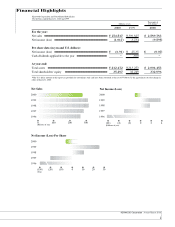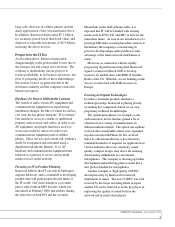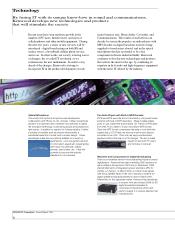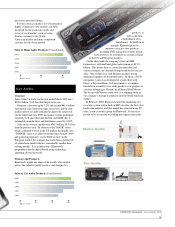Kenwood 2000 Annual Report Download - page 12
Download and view the complete annual report
Please find page 12 of the 2000 Kenwood annual report below. You can navigate through the pages in the report by either clicking on the pages listed below, or by using the keyword search tool below to find specific information within the annual report.
Telephones and
Mobile Communications
Review of Operations
Communications
Equipment
KENWOOD Corporation Annual Report 2000
10
Communications equipment is another pillar of
Kenwood's business and includes telephones, mobile
communications equipment, and wireless radio
equipment. As network operators are starting to offer
more diversified services, mobile terminals such as
cellular phones and PHS terminals are no longer
simple communication tools, but are information
terminals which have such functions as information
gathering and dispatching. Kenwood offers a range
of attractive terminals utilizing its know-how in the
fields of telecommunications and audio.
As for radio communications systems, there are
persistent demands for commercial applications
throughout the world, although the demand for
amateur radio is shrinking.
Kenwood's high
performance radio
equipment is highly valued
in the world market for
individual homes, and
offices, as well as public
institutions.
Overview
Total sales for telephones and communications equipment
during the year ended March 2000 were ¥30.9 billion, down
31.5% from the previous year. In the field of home
telephone, however, Kenwood held its place in the matured
market by achieving the same level of sales as the previous
year. A new all-in-one model with functionality of a fax
machine was added to the lineup of cordless telephone
answering machines. Kenwood looks for a steady growth
by expanding its product range.
In mobile communications, a decline in sales resulted
from a delay in the introduction of PDC (cellular phones).
Only one new model of PDC could be marketed before the
end of the period. Meanwhile, with PHS (Personal Handy-
phone System), a new model was developed in accordance
with the H" standard released by DDI Pocket and it gained
immediate popularity in the marketplace.
Strategies and Prospects
In Japan, PDC and PHS terminals are undergoing a series of
transformations these days: clarity of voice, high-speed data
communication, e-mailing, browsing the Web, a color LCD
display ... the list goes on and on. To survive in an ever-
changing market like this, a company must be ready to
develop one product after another in accordance with
shifting demands and the requirements of network
operators. In other words, one must be able to foresee the
direction each network operator is headed and continually
work on future products.
To achieve stable growth in the cellular (PDC) phone
business, we now make it a rule that two new models must
be made available each year. Since the summer of 1999, a
new system has been implemented to develop products with
two separate teams. The change will be reflected in
products scheduled for introduction this coming fall.
In addition, new cellular phone services using IMT-2000
or W-CDMA will become available in Japan next year. At
Kenwood, development of a W-CDMA mobile terminal has
been underway since December 1998. Commercial
production of IMT-2000 or W-CDMA mobile terminals will
start in the year 2001.
Overseas, the GSM business has entered a new phase and
is gaining momentum in expansion. GSM cellular phones
are widely used throughout the world, especially in
Europe and Asia. At the moment, annual demand
for new terminals is estimated to be around
300 million units (or even 400 million).
Kenwood has developed its own
GSM terminals at the R&D
Center established in the UK
and has been successful
Percent of Net Sales
22.9%
























